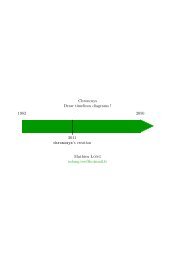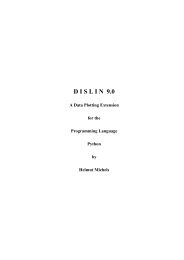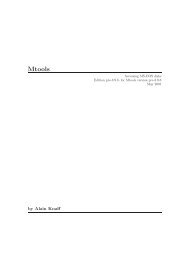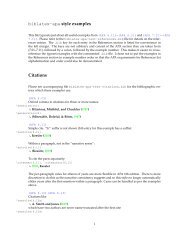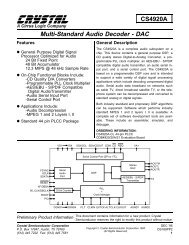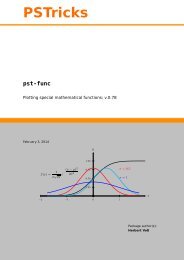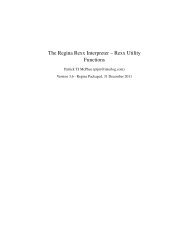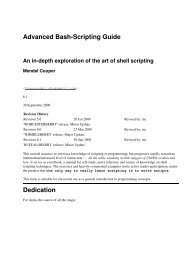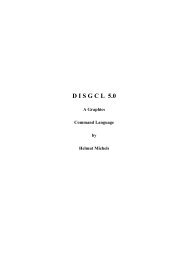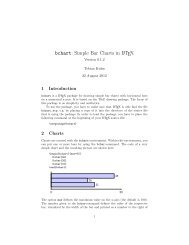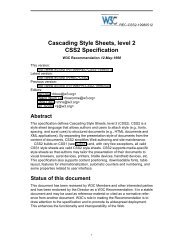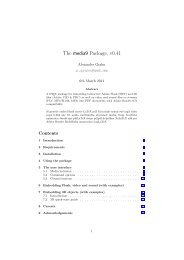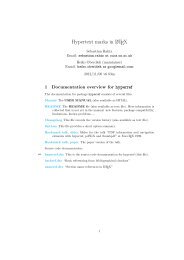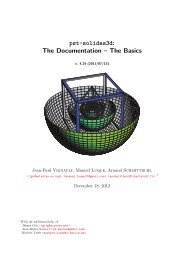Manual for the csvsimple package
Manual for the csvsimple package
Manual for the csvsimple package
- No tags were found...
Create successful ePaper yourself
Turn your PDF publications into a flip-book with our unique Google optimized e-Paper software.
The <strong>csvsimple</strong> <strong>package</strong><strong>Manual</strong> <strong>for</strong> version 1.07 (2013/09/25)Thomas F. Sturm 1Abstract<strong>csvsimple</strong> provides a simple L A TEX interface <strong>for</strong> <strong>the</strong> processing of files with commaseparated values (CSV). <strong>csvsimple</strong> relies heavily on <strong>the</strong> key value syntax frompgfkeys which results (hopefully) in an easy way of usage. Filtering and table generationis especially supported. Since <strong>the</strong> <strong>package</strong> is considered as a lightweight tool,<strong>the</strong>re is no support <strong>for</strong> data sorting or data base storage.Contents1 Introduction 11.1 Loading <strong>the</strong> Package . . . . . . . . . . . . . . . . . . . . . . . . . . . . . . . . . . 21.2 First Steps . . . . . . . . . . . . . . . . . . . . . . . . . . . . . . . . . . . . . . . 22 Macros <strong>for</strong> <strong>the</strong> Processing of CSV Files 63 Option Keys 113.1 Command Definition . . . . . . . . . . . . . . . . . . . . . . . . . . . . . . . . . . 113.2 Header Processing and Column Name Assignment . . . . . . . . . . . . . . . . . 123.3 Consistency Check and Filtering . . . . . . . . . . . . . . . . . . . . . . . . . . . 133.4 Table Support . . . . . . . . . . . . . . . . . . . . . . . . . . . . . . . . . . . . . . 143.5 Miscellaneous . . . . . . . . . . . . . . . . . . . . . . . . . . . . . . . . . . . . . . 154 Examples 174.1 A Serial Letter . . . . . . . . . . . . . . . . . . . . . . . . . . . . . . . . . . . . . 174.2 A Graphical Presentation . . . . . . . . . . . . . . . . . . . . . . . . . . . . . . . 194.3 Macro code inside <strong>the</strong> data . . . . . . . . . . . . . . . . . . . . . . . . . . . . . . 22References 23Index 241 IntroductionThe <strong>csvsimple</strong> <strong>package</strong> is applied to <strong>the</strong> processing of CSV 2 files. This processing is controlledby key value assignments according to <strong>the</strong> syntax of pgfkeys [3]. Sample applications of <strong>the</strong><strong>package</strong> are tabular lists, serial letters, and charts.An alternative to <strong>csvsimple</strong> is <strong>the</strong> datatool <strong>package</strong> [2] which provides considerably morefunctions like exchange of separator and delimiter symbols or sorting of data. <strong>csvsimple</strong> hasa different approach <strong>for</strong> <strong>the</strong> user interface and is deliberately restricted to some basic functionswith fast processing speed.1 Prof. Dr. Dr. Thomas F. Sturm, Institut für Ma<strong>the</strong>matik und In<strong>for</strong>matik, Universität der BundeswehrMünchen, D-85577 Neubiberg, Germany; email: thomas.sturm@unibw.de2 CSV file: file with comma separated values.1
1.1 Loading <strong>the</strong> PackageThe <strong>package</strong> <strong>csvsimple</strong> loads <strong>the</strong> <strong>package</strong>s pgfkeys [3] and if<strong>the</strong>n [1]. <strong>csvsimple</strong> itself isloaded in <strong>the</strong> usual manner in <strong>the</strong> preamble:\use<strong>package</strong>{<strong>csvsimple</strong>}1.2 First StepsEvery line of a processable CSV file has to contain an identical amount of comma 3 separatedvalues. The curly braces {} of TEX groups can be used to mask a block which may containcommas not to be processed as separators.The first line of such a CSV file is usually but not necessarily a header line which contains <strong>the</strong>identifiers <strong>for</strong> each column.CSV file grade.csvname,givenname,matriculation,gender,gradeMaier,Hans,12345,m,1.0Huber,Anna,23456,f,2.3Wei\ss{}b\"{a}ck,Werner,34567,m,5.0The most simple way to display a CSV file in tabular <strong>for</strong>m is <strong>the</strong> processing with <strong>the</strong>\csvautotabular → P. 7 command.\csvautotabular{grade.csv}name givenname matriculation gender gradeMaier Hans 12345 m 1.0Huber Anna 23456 f 2.3Weißbäck Werner 34567 m 5.0Typically, one would use \csvreader → P. 6 instead of \csvautotabular to gain full control over<strong>the</strong> interpretation of <strong>the</strong> included data.In <strong>the</strong> following example, <strong>the</strong> entries of <strong>the</strong> header line are automatically assigned to TEX macroswhich may be used deliberately.\begin{tabular}{|l|c|}\hline%\bfseries Person & \bfseries Matr.~No.\csvreader[head to column names]{grade.csv}{}%{\\\givenname\ \name & \matriculation}%\\\hline\end{tabular}PersonMatr. No.Hans Maier 12345Anna Huber 23456Werner Weißbäck 345673 See /csv/separator → P. 15 <strong>for</strong> o<strong>the</strong>r separators than comma.2
\csvreader is controlled by a plenty of options. For example, <strong>for</strong> table applications line breaksare easily inserted by /csv/late after line → P. 11 . This defines a macro execution just be<strong>for</strong>e<strong>the</strong> following line. Additionally, <strong>the</strong> assignment of columns to TEX macros is shown in a nonautomated way.\begin{tabular}{|r|l|c|}\hline%& Person & Matr.~No.\\\hline\hline\csvreader[late after line=\\\hline]%{grade.csv}{name=\name,givenname=\firstname,matriculation=\matnumber}%{\<strong>the</strong>csvrow & \firstname~\name & \matnumber}%\end{tabular}PersonMatr. No.1 Hans Maier 123452 Anna Huber 234563 Werner Weißbäck 34567An even more com<strong>for</strong>table way to create a table is setting appropriate option keys. Note, thatthis gives you <strong>the</strong> possibility to create a pgfkeys style which contains <strong>the</strong> whole table creation.\csvreader[tabular=|r|l|c|,table head=\hline & Person & Matr.~No.\\\hline\hline,late after line=\\\hline]%{grade.csv}{name=\name,givenname=\firstname,matriculation=\matnumber}%{\<strong>the</strong>csvrow & \firstname~\name & \matnumber}%PersonMatr. No.1 Hans Maier 123452 Anna Huber 234563 Werner Weißbäck 34567The next example shows such a style definition with <strong>the</strong> convenience macro \csvstyle → P. 8 .Here, we see again <strong>the</strong> automated assignment of header entries to column names by /csv/headto column names → P. 12 . For this, <strong>the</strong> header entries have to be without spaces and specialcharacters. But you can always assign entries to canonical macro names by hand like in <strong>the</strong>examples above.\csvstyle{myTableStyle}{tabular=|r|l|c|,table head=\hline & Person & Matr.~No.\\\hline\hline,late after line=\\\hline,head to column names}\csvreader[myTableStyle]{grade.csv}{}%{\<strong>the</strong>csvrow & \givenname~\name & \matriculation}%PersonMatr. No.1 Hans Maier 123452 Anna Huber 234563 Werner Weißbäck 345673
Ano<strong>the</strong>r way to address columns is to use <strong>the</strong>ir roman numbers. The direct addressing is doneby \csvcoli, \csvcolii, \csvcoliii, . . . :\csvreader[tabular=|r|l|c|,table head=\hline & Person & Matr.~No.\\\hline\hline,late after line=\\\hline]%{grade.csv}{}%{\<strong>the</strong>csvrow & \csvcolii~\csvcoli & \csvcoliii}%PersonMatr. No.1 Hans Maier 123452 Anna Huber 234563 Werner Weißbäck 34567And yet ano<strong>the</strong>r method to assign macros to columns is to use arabic numbers <strong>for</strong> <strong>the</strong> assignment:\csvreader[tabular=|r|l|c|,table head=\hline & Person & Matr.~No.\\\hline\hline,late after line=\\\hline]%{grade.csv}{1=\name,2=\firstname,3=\matnumber}%{\<strong>the</strong>csvrow & \firstname~\name & \matnumber}%PersonMatr. No.1 Hans Maier 123452 Anna Huber 234563 Werner Weißbäck 34567For recurring applications, <strong>the</strong> pgfkeys syntax allows to create own styles <strong>for</strong> a consistentand centralized design. The following example is easily modified to obtain more or less optionsettings.\csvset{myStudentList/.style={%tabular=|r|l|c|,table head=\hline & Person & #1\\\hline\hline,late after line=\\\hline,column names={name=\name,givenname=\firstname}}}\csvreader[myStudentList={Matr.~No.}]{grade.csv}{matriculation=\matnumber}%{\<strong>the</strong>csvrow & \firstname~\name & \matnumber}%\hfill%\csvreader[myStudentList={Grade}]{grade.csv}{grade=\grade}%{\<strong>the</strong>csvrow & \firstname~\name & \grade}%PersonMatr. No.1 Hans Maier 123452 Anna Huber 234563 Werner Weißbäck 34567PersonGrade1 Hans Maier 1.02 Anna Huber 2.33 Werner Weißbäck 5.04
Alternatively, column names can be set by \csvnames → P. 8 and style definitions by\csvstyle → P. 8 . With this, <strong>the</strong> last example is rewritten as follows:\csvnames{myNames}{1=\name,2=\firstname,3=\matnumber,5=\grade}\csvstyle{myStudentList}{tabular=|r|l|c|,table head=\hline & Person & #1\\\hline\hline,late after line=\\\hline, myNames}\csvreader[myStudentList={Matr.~No.}]{grade.csv}{}%{\<strong>the</strong>csvrow & \firstname~\name & \matnumber}%\hfill%\csvreader[myStudentList={Grade}]{grade.csv}{}%{\<strong>the</strong>csvrow & \firstname~\name & \grade}%PersonMatr. No.1 Hans Maier 123452 Anna Huber 234563 Werner Weißbäck 34567PersonGrade1 Hans Maier 1.02 Anna Huber 2.33 Werner Weißbäck 5.0The data lines of a CSV file can also be filtered. In <strong>the</strong> following example, a certificate is printedonly <strong>for</strong> students with grade unequal to 5.0.\csvreader[filter not equal={\grade}{5.0}]%{grade.csv}{1=\name,2=\firstname,3=\matnumber,4=\gender,5=\grade}%{\begin{center}\Large\bfseries Certificate in Ma<strong>the</strong>matics\end{center}\large\if<strong>the</strong>nelse{\equal{\gender}{f}}{Ms.}{Mr.}\firstname~\name, matriculation number \matnumber, has passed <strong>the</strong> testin ma<strong>the</strong>matics with grade \grade.\par\ldots\par}%Certificate in Ma<strong>the</strong>maticsMr. Hans Maier, matriculation number 12345, has passed <strong>the</strong> test in ma<strong>the</strong>maticswith grade 1.0.. . .Certificate in Ma<strong>the</strong>maticsMs. Anna Huber, matriculation number 23456, has passed <strong>the</strong> test in ma<strong>the</strong>maticswith grade 2.3.. . .5
2 Macros <strong>for</strong> <strong>the</strong> Processing of CSV Files\csvreader[〈options〉]{〈file name〉}{〈assignments〉}{〈command list〉}\csvreader reads <strong>the</strong> file denoted by 〈file name〉 line by line. Every line of <strong>the</strong> file has tocontain an identical amount of comma separated values. The curly braces {} of TEX groupscan be used to mask a block which may contain commas not to be processed as separators.The first line of such a CSV file is by default but not necessarily processed as a headerline which contains <strong>the</strong> identifiers <strong>for</strong> each column. The entries of this line can be used togive 〈assignments〉 to TEX macros to address <strong>the</strong> columns. The number of entries of thisfirst line determines <strong>the</strong> accepted number of entries <strong>for</strong> all following lines. Every line whichcontains a higher or lower number of entries is ignored during standard processing.The 〈assignments〉 are given by key value pairs 〈name〉=〈macro〉. Here, 〈name〉 is an entryfrom <strong>the</strong> header line or <strong>the</strong> arabic number of <strong>the</strong> addressed column. 〈macro〉 is some TEXmacro which gets <strong>the</strong> content of <strong>the</strong> addressed column.The 〈command list〉 is executed <strong>for</strong> every accepted data line. Inside <strong>the</strong> 〈command list〉 isapplicable:• \<strong>the</strong>csvrow or <strong>the</strong> counter csvrow which contains <strong>the</strong> number of <strong>the</strong> current data line(starting with 1).• \csvcoli, \csvcolii, \csvcoliii, . . . , which contain <strong>the</strong> contents of <strong>the</strong> columnentries of <strong>the</strong> current data line. Alternatively can be used:• 〈macro〉 from <strong>the</strong> 〈assignments〉 to have a logical addressing of a column entry.Note, that <strong>the</strong> 〈command list〉 is allowed to contain \par and that all macro definitions aremade global to be used <strong>for</strong> table applications.The processing of <strong>the</strong> given CSV file can be controlled by various 〈options〉 given as keyvalue list. The feasible option keys are described in section 3 from page 11.\csvreader[tabular=|r|l|l|, table head=\hline, late after line=\\,late after last line=\\\hline]{grade.csv}%{name=\name,givenname=\firstname,grade=\grade}%{\grade & \firstname~\name & \csvcoliii}1.0 Hans Maier 123452.3 Anna Huber 234565.0 Werner Weißbäck 34567Mainly, <strong>the</strong> \csvreader command consists of a \csvloop macro with following parameters:\csvloop{〈options〉, file=〈file name〉, column names=〈assignments〉,command=〈command list〉}There<strong>for</strong>e, <strong>the</strong> application of <strong>the</strong> keys /csv/file → P. 16 and /csv/command → P. 11 is useless<strong>for</strong> \csvreader.\csvloop{〈options〉}Usually, \csvreader may be preferred instead of \csvloop. \csvreader is based on\csvloop which takes a mandatory list of 〈options〉 in key value syntax. This list of〈options〉 controls <strong>the</strong> total processing. Especially, it has to contain <strong>the</strong> CSV file name.\csvloop{file={grade.csv}, column names={name=\name}, command=\name,be<strong>for</strong>e reading={List of students:\ },late after line={{,}\ }, late after last line=.}List of students: Maier, Huber, Weißbäck.6
\csvautotabular[〈options〉]{〈file name〉}\csvautotabular is an abbreviation <strong>for</strong> <strong>the</strong> application of <strong>the</strong> option key/csv/autotabular → P. 14 toge<strong>the</strong>r with o<strong>the</strong>r 〈options〉 to \csvloop → P. 6 . This macroreads <strong>the</strong> whole CSV file denoted by 〈file name〉 with an automated <strong>for</strong>matting.\csvautotabular{grade.csv}name givenname matriculation gender gradeMaier Hans 12345 m 1.0Huber Anna 23456 f 2.3Weißbäck Werner 34567 m 5.0\csvautotabular[filter equal={\csvcoliv}{f}]{grade.csv}name givenname matriculation gender gradeHuber Anna 23456 f 2.3\csvautolongtable[〈options〉]{〈file name〉}csvautolongtable is an abbreviation <strong>for</strong> <strong>the</strong> application of <strong>the</strong> option key/csv/autolongtable → P. 14 toge<strong>the</strong>r with o<strong>the</strong>r 〈options〉 to \csvloop → P. 6 . This macroreads <strong>the</strong> whole CSV file denoted by 〈file name〉 with an automated <strong>for</strong>matting. Forapplication, <strong>the</strong> <strong>package</strong> longtable is required which has to be loaded in <strong>the</strong> preamble.\csvautolongtable{grade.csv}name givenname matriculation gender gradeMaier Hans 12345 m 1.0Huber Anna 23456 f 2.3Weißbäck Werner 34567 m 5.07
\csvset{〈options〉}Sets 〈options〉 <strong>for</strong> every following \csvreader → P. 6 and \csvloop → P. 6 . For example, thiscommand may be used <strong>for</strong> style definitions.\csvset{grade list/.style={column names={name=\name,givenname=\firstname,grade=\grade}},passed/.style={filter not equal={\grade}{5.0}} }The following students passed <strong>the</strong> test in ma<strong>the</strong>matics:\csvreader[grade list,passed]{grade.csv}{}{\firstname\ \name\ (\grade); }%The following students passed <strong>the</strong> test in ma<strong>the</strong>matics: Hans Maier (1.0); Anna Huber (2.3);\csvstyle{〈Stilname〉}{〈options〉}Abbreviation <strong>for</strong> \csvset{〈style name〉/.style={〈options〉}} to define a new style.\csvnames{〈Stilname〉}{〈Zuweisungsliste〉}Abbreviation <strong>for</strong> \csvset{〈style name〉/.style={column names={〈assignments〉}}} to defineadditional 〈assignments〉 of macros to columns.\csvnames{grade list}{name=\name,givenname=\firstname,grade=\grade}\csvstyle{passed}{filter not equal={\grade}{5.0}}The following students passed <strong>the</strong> test in ma<strong>the</strong>matics:\csvreader[grade list,passed]{grade.csv}{}{\firstname\ \name\ (\grade); }%The following students passed <strong>the</strong> test in ma<strong>the</strong>matics: Hans Maier (1.0); Anna Huber (2.3);\csvheadset{〈assignments〉}For some special cases, this command can be used to change <strong>the</strong> 〈assignments〉 of macrosto columns during execution of \csvreader → P. 6 and \csvloop → P. 6 .\csvreader{grade.csv}{}%{ \csvheadset{name=\n} \fbox{\n}\csvheadset{givenname=\n} \ldots\ \fbox{\n} }%Maier . . . Hans Huber . . . Anna Weißbäck . . . Werner8
\csviffirstrow{〈<strong>the</strong>n macros〉}{〈else macros〉}Inside <strong>the</strong> command list of \csvreader → P. 6 , <strong>the</strong> 〈<strong>the</strong>n macros〉 are executed <strong>for</strong> <strong>the</strong> firstdata line, and <strong>the</strong> 〈else macros〉 are executed <strong>for</strong> all following lines.\csvreader[tabbing, head to column names, table head=\hspace*{3cm}\=\kill]%{grade.csv}{}%{\givenname~\name \> (\csviffirstrow{first entry!!}{following entry})}Hans MaierAnna HuberWerner Weißbäck(first entry!!)(following entry)(following entry)\csvifoddrow{〈<strong>the</strong>n macros〉}{〈else macros〉}Inside <strong>the</strong> command list of \csvreader → P. 6 , <strong>the</strong> 〈<strong>the</strong>n macros〉 are executed <strong>for</strong> oddnumbereddata lines, and <strong>the</strong> 〈else macros〉 are executed <strong>for</strong> even-numbered lines.\csvreader[head to column names,tabular=|l|l|l|l|,table head=\hline\bfseries \# & \bfseries Name & \bfseries Grade\\\hline,late after line=\\, late after last line=\\\hline]{grade.csv}{}{%\csvifoddrow{\slshape\<strong>the</strong>csvrow & \slshape\name, \givenname & \slshape\grade}%{\bfseries\<strong>the</strong>csvrow & \bfseries\name, \givenname & \bfseries\grade}}# Name Grade1 Maier, Hans 1.02 Huber, Anna 2.33 Weißbäck, Werner 5.0The \csvifoddrow macro may be used <strong>for</strong> striped tables:% This example needs <strong>the</strong> xcolor <strong>package</strong>\csvreader[head to column names,tabular=rlcc,table head=\hline\rowcolor{red!50!black}\color{white}\# & \color{white}Person& \color{white}Matr.~No. & \color{white}Grade,late after head=\\\hline\rowcolor{yellow!50},late after line=\csvifoddrow{\\\rowcolor{yellow!50}}{\\\rowcolor{red!25}}]%{grade.csv}{}%{\<strong>the</strong>csvrow & \givenname~\name & \matriculation & \grade}%# Person Matr. No. Grade1 Hans Maier 12345 1.02 Anna Huber 23456 2.33 Werner Weißbäck 34567 5.0Alternatively, \rowcolors from <strong>the</strong> xcolor <strong>package</strong> can be used <strong>for</strong> this purpose:% This example needs <strong>the</strong> xcolor <strong>package</strong>\csvreader[tabular=rlcc, be<strong>for</strong>e table=\rowcolors{2}{red!25}{yellow!50},table head=\hline\rowcolor{red!50!black}\color{white}\# & \color{white}Person& \color{white}Matr.~No. & \color{white}Grade\\\hline,late after line=\\,head to column names]{grade.csv}{}%{\<strong>the</strong>csvrow & \givenname~\name & \matriculation & \grade}%# Person Matr. No. Grade1 Hans Maier 12345 1.02 Anna Huber 23456 2.33 Werner Weißbäck 34567 5.09
\csvfilteracceptAll following consistent data lines will be accepted and processed. This command overwritesall previous filter settings and may be used inside /csv/be<strong>for</strong>e filter → P. 11 to implementan own filtering rule toge<strong>the</strong>r with \csvfilterreject.\csvreader[autotabular,be<strong>for</strong>e filter=\if<strong>the</strong>nelse{\equal{\csvcoliv}{m}}{\csvfilteraccept}{\csvfilterreject}]{grade.csv}{}{\csvlinetotablerow}%name givenname matriculation gender gradeMaier Hans 12345 m 1.0Weißbäck Werner 34567 m 5.0\csvfilterrejectAll following data lines will be ignored. This command overwrites all previous filter settings.\csvlineThis macro contains <strong>the</strong> current and unprocessed data line.\csvreader[no head, tabbing, table head=\textit{line XX:}\=\kill]%{grade.csv}{}{\textit{line \<strong>the</strong>csvrow:} \> \csvline}%line 1:line 2:line 3:line 4:name,givenname,matriculation,gender,gradeMaier,Hans,12345,m,1.0Huber,Anna,23456,f,2.3Weißbäck,Werner,34567,m,5.0\<strong>the</strong>csvrowTypesets <strong>the</strong> current data line number. This is <strong>the</strong> current number of accepted data lineswithout <strong>the</strong> header line. The L A TEX counter csvrow can be addressed directly in <strong>the</strong> usualway, e. g. by \roman{csvrow}.\<strong>the</strong>csvinputlineTypesets <strong>the</strong> current file line number. This is <strong>the</strong> current number of all data lines including<strong>the</strong> header line. The L A TEX counter csvinputline can be addressed directly in <strong>the</strong> usualway, e. g. by \roman{csvinputline}.\csvreader[no head, filter equal={\<strong>the</strong>csvinputline}{3}]%{grade.csv}{}%{The line with number \<strong>the</strong>csvinputline\ contains: \csvline}%The line with number 3 contains: Huber,Anna,23456,f,2.3\csvlinetotablerowTypesets <strong>the</strong> current processed data line with & between <strong>the</strong> entries. Most users will neverapply this command.10
3 Option KeysFor <strong>the</strong> 〈options〉 in \csvreader → P. 6 respectively \csvloop → P. 6 <strong>the</strong> following pgf keys can beapplied. The key tree path /csv/ is not to be used inside <strong>the</strong>se macros.3.1 Command Definition/csv/be<strong>for</strong>e reading=〈macros〉(no default, initially empty)Sets <strong>the</strong> 〈macros〉 to be executed be<strong>for</strong>e <strong>the</strong> CSV file is processed./csv/after head=〈macros〉(no default, initially empty)Sets <strong>the</strong> 〈macros〉 to be executed after <strong>the</strong> header line is read./csv/be<strong>for</strong>e filter=〈macros〉(no default, initially empty)Sets <strong>the</strong> 〈macros〉 to be executed after reading and consistency checking of a data line.They are executed be<strong>for</strong>e any filter condition is checked, see /csv/filter → P. 13 ./csv/late after head=〈macros〉(no default, initially empty)Sets <strong>the</strong> 〈macros〉 to be executed after reading and disassembling of <strong>the</strong> first accepted dataline. They are executed be<strong>for</strong>e fur<strong>the</strong>r processing of this line./csv/late after line=〈macros〉(no default, initially empty)Sets <strong>the</strong> 〈macros〉 to be executed after reading and disassembling of <strong>the</strong> next accepted dataline (after /csv/be<strong>for</strong>e filter). They are executed be<strong>for</strong>e fur<strong>the</strong>r processing of this nextline. late after line overwrites late after first line and late after last line./csv/late after first line=〈macros〉(no default, initially empty)Sets <strong>the</strong> 〈macros〉 to be executed after reading and disassembling of <strong>the</strong> second accepteddata line instead of /csv/late after line. This key has to be set after late after line./csv/late after last line=〈macros〉(no default, initially empty)Sets <strong>the</strong> 〈macros〉 to be executed after processing of <strong>the</strong> last accepted data line instead of/csv/late after line. This key has to be set after late after line./csv/be<strong>for</strong>e line=〈macros〉(no default, initially empty)Sets <strong>the</strong> 〈macros〉 to be executed after /csv/late after line and be<strong>for</strong>e /csv/command.be<strong>for</strong>e line overwrites be<strong>for</strong>e first line./csv/be<strong>for</strong>e first line=〈macros〉(no default, initially empty)Sets <strong>the</strong> 〈macros〉 to be executed instead of /csv/be<strong>for</strong>e line <strong>for</strong> <strong>the</strong> first accepted dataline. This key has to be set after be<strong>for</strong>e line./csv/command=〈macros〉(no default, initially \csvline)Sets <strong>the</strong> 〈macros〉 to be executed <strong>for</strong> every accepted data line. They are executed between/csv/be<strong>for</strong>e line and /csv/after line./csv/after line=〈macros〉(no default, initially empty)Sets <strong>the</strong> 〈macros〉 to be executed <strong>for</strong> every accepted data line after /csv/command.after line overwrites after first line./csv/after first line=〈macros〉(no default, initially empty)Sets <strong>the</strong> 〈macros〉 to be executed instead of /csv/after line <strong>for</strong> <strong>the</strong> first accepted dataline. This key has to be set after after line./csv/after reading=〈macros〉(no default, initially empty)Sets <strong>the</strong> 〈macros〉 to be executed after <strong>the</strong> CSV file is processed.11
\csvreader[be<strong>for</strong>e reading = \meta{be<strong>for</strong>e reading}\\,after head= \meta{after head},be<strong>for</strong>e filter = \\\meta{be<strong>for</strong>e filter},late after head = \meta{late after head},late after line = \meta{late after line},late after first line = \meta{late after first line},late after last line = \\\meta{late after last line},be<strong>for</strong>e line= \meta{be<strong>for</strong>e line},be<strong>for</strong>e first line = \meta{be<strong>for</strong>e first line},after line= \meta{after line},after first line = \meta{after first line},after reading = \\\meta{after reading}]{grade.csv}{name=\name}{\textbf{\name}}%〈be<strong>for</strong>e reading〉〈after head〉〈be<strong>for</strong>e filter〉〈late after head〉〈be<strong>for</strong>e first line〉Maier〈after first line〉〈be<strong>for</strong>e filter〉〈late after first line〉〈be<strong>for</strong>e line〉Huber〈after line〉〈be<strong>for</strong>e filter〉〈late after line〉〈be<strong>for</strong>e line〉Weißbäck〈after line〉〈late after last line〉〈after reading〉Additional command definition keys are provided <strong>for</strong> <strong>the</strong> supported tables, see section 3.4 frompage 14.3.2 Header Processing and Column Name Assignment/csv/head=〈boolean value〉(default true, initially true)If this key is set, <strong>the</strong> first line of <strong>the</strong> CSV file is treated as a header line which can be used<strong>for</strong> column name assignments./csv/no head(no value)Abbreviation <strong>for</strong> head=false, i. e. <strong>the</strong> first line of <strong>the</strong> CSV file is treated as data line./csv/column names=〈assignments〉(no default, initially empty)Adds some new 〈assignments〉 of macros to columns in key value syntax. Existing assignmentsare kept./csv/column names resetClears all assignments of macros to columns.(no value)/csv/head to column names=〈boolean value〉(default true, initially false)If this key is set, <strong>the</strong> entries of <strong>the</strong> header line are used automatically as macro names <strong>for</strong><strong>the</strong> columns. This option can be used only, if <strong>the</strong> header entries do not contain spaces andspecial characters to be used as feasible L A TEX macro names.12
3.3 Consistency Check and Filtering/csv/check column count=〈boolean value〉(default true, initially true)This key defines, if <strong>the</strong> number of entries in a data line is checked against an expected value.If true, every non consistent line is ignored without announcement.If false, every line is accepted and may produce an error during fur<strong>the</strong>r processing./csv/no check column countAbbreviation <strong>for</strong> check column count=false.(no value)/csv/column count=〈number〉(no default)Sets <strong>the</strong> 〈number〉 of feasible entries per data line. This setting is only useful in connectionwith /csv/no head → P. 12 , since 〈number〉 would be replaced by <strong>the</strong> number of entries in<strong>the</strong> header line o<strong>the</strong>rwise./csv/on column count error=〈macros〉〈macros〉 to be executed <strong>for</strong> unfeasible data lines./csv/warn on column count errorDisplay of a warning <strong>for</strong> unfeasible data lines.(no default, initially empty)(style, no value)/csv/filter=〈condition〉(no default)Only data lines which fulfill a logical 〈condition〉 are accepted. For <strong>the</strong> 〈condition〉, everyterm from <strong>the</strong> if<strong>the</strong>n <strong>package</strong> [1] is feasible. To preprocess <strong>the</strong> data line be<strong>for</strong>e testing <strong>the</strong>〈condition〉, <strong>the</strong> option key /csv/be<strong>for</strong>e filter → P. 11 can be used./csv/no filterClears a set filter./csv/filter accept allAlias <strong>for</strong> no filter. All consistent data lines are accepted./csv/filter reject allAll data line are ignored.(no value, initially set)(no value, initially set)(no value)/csv/filter equal={〈string A〉}{〈string B〉}(style, no default)Only lines where 〈string A〉 and 〈string B〉 are equal after expansion are accepted./csv/filter not equal={〈string A〉}{〈string B〉}(style, no default)Only lines where 〈string A〉 and 〈string B〉 are not equal after expansion are accepted.13
3.4 Table Support/csv/tabular=〈table <strong>for</strong>mat〉(style, no default)Surrounds <strong>the</strong> CSV processing with \begin{tabular}{〈table <strong>for</strong>mat〉} at begin andwith \end{tabular} at end. Additionally, <strong>the</strong> commands defined by <strong>the</strong> key values of/csv/be<strong>for</strong>e table, /csv/table head, /csv/table foot, and /csv/after table are executedat <strong>the</strong> appropriate places./csv/centered tabular=〈table <strong>for</strong>mat〉Like /csv/tabular but inside an additional center environment./csv/longtable=〈table <strong>for</strong>mat〉Like /csv/tabular but <strong>for</strong> <strong>the</strong> longtable environment.longtable (not loaded automatically)./csv/tabbingLike /csv/tabular but <strong>for</strong> <strong>the</strong> tabbing environment./csv/centered tabbingLike /csv/tabbing but inside an additional center environment./csv/no tableDeactivates tabular, longtable, and tabbing.(style, no default)(style, no default)This requires <strong>the</strong> <strong>package</strong>(style, no value)(style, no value)(style, no value)/csv/be<strong>for</strong>e table=〈macros〉(no default, initially empty)Sets <strong>the</strong> 〈macros〉 to be executed be<strong>for</strong>e \begin{tabular} or be<strong>for</strong>e \begin{longtable}or be<strong>for</strong>e \begin{tabbing}, respectively./csv/table head=〈macros〉(no default, initially empty)Sets <strong>the</strong> 〈macros〉 to be executed after \begin{tabular} or after \begin{longtable} orafter \begin{tabbing}, respectively./csv/table foot=〈macros〉(no default, initially empty)Sets <strong>the</strong> 〈macros〉 to be executed be<strong>for</strong>e \end{tabular} or be<strong>for</strong>e \end{longtable} orbe<strong>for</strong>e \end{tabbing}, respectively./csv/after table=〈macros〉(no default, initially empty)Sets <strong>the</strong> 〈macros〉 to be executed after \end{tabular} or after \end{longtable} or after\end{tabbing}, respectively./csv/autotabular=〈file name〉(no default)Reads <strong>the</strong> whole CSV file denoted 〈file name〉 with an automated <strong>for</strong>matting./csv/autolongtable=〈file name〉(no default)Reads <strong>the</strong> whole CSV file denoted 〈file name〉 with an automated <strong>for</strong>matting using <strong>the</strong>required longtable <strong>package</strong>.14
3.5 Miscellaneous/csv/every csv(style, initially empty)A style definition which is used <strong>for</strong> every following CSV file. This definition can be overwrittenwith user code.% Sets a warning message <strong>for</strong> unfeasible data lines.\csvset{every csv/.style={warn on column count error}}% Alternatively:\csvstyle{every csv}{warn on column count error}/csv/default(style)A style definition which is used <strong>for</strong> every following CSV file which resets all settings todefault values 4 . This key should not be used or changed by <strong>the</strong> user if <strong>the</strong>re is not a reallygood reason (and you know what you do)./csv/separator=〈sign〉(no default, initially comma)Sets <strong>the</strong> 〈sign〉 which is treates as separator between <strong>the</strong> data values of a data line. Feasiblevalues are:• comma: This is <strong>the</strong> initial value with ’,’ as separator.• semicolon: Sets <strong>the</strong> separator to ’;’.% \use<strong>package</strong>{tcolorbox} <strong>for</strong> tcbverbatimwrite\begin{tcbverbatimwrite}{testsemi.csv}name;givenname;matriculation;gender;gradeMaier;Hans;12345;m;1.0Huber;Anna;23456;f;2.3Wei\ss{}b\"{a}ck;Werner;34567;m;5.0\end{tcbverbatimwrite}\csvautotabular[separator=semicolon]{testsemi.csv}name givenname matriculation gender gradeMaier Hans 12345 m 1.0Huber Anna 23456 f 2.3Weißbäck Werner 34567 m 5.0• pipe: Sets <strong>the</strong> separator to ’|’.% \use<strong>package</strong>{tcolorbox} <strong>for</strong> tcbverbatimwrite\begin{tcbverbatimwrite}{pipe.csv}name|givenname|matriculation|gender|gradeMaier|Hans|12345|m|1.0Huber|Anna|23456|f|2.3Wei\ss{}b\"{a}ck|Werner|34567|m|5.0\end{tcbverbatimwrite}\csvautotabular[separator=pipe]{pipe.csv}name givenname matriculation gender gradeMaier Hans 12345 m 1.0Huber Anna 23456 f 2.3Weißbäck Werner 34567 m 5.04 default is used because of <strong>the</strong> global nature of most settings.15
csv/file=〈file name〉Sets <strong>the</strong> 〈file name〉 of <strong>the</strong> CSV file to be processed.(no default, initially unknown.csv)/csv/preprocessed file=〈file name〉(no default, initially unused)Sets <strong>the</strong> 〈file name〉 of <strong>the</strong> CSV file which is <strong>the</strong> output of a preprocessor./csv/preprocessor=〈macro〉(no default)Defines a preprocessor <strong>for</strong> <strong>the</strong> given CSV file. The 〈macro〉 has to have two mandatoryarguments. The first argument is <strong>the</strong> original CSV file which is set by /csv/file. Thesecond argument is <strong>the</strong> preprocessed CSV file which is set by /csv/preprocessed file.Typically, <strong>the</strong> 〈macro〉 may call an external program which preprocesses <strong>the</strong> original CSVfile (e. g. sorting <strong>the</strong> file) and creates <strong>the</strong> preprocessed CSV file. The later file is used by\csvreader → P. 6 or \csvloop → P. 6 .\newcommand{\mySortTool}[2]{%% call to an external program to sort file #1 with resulting file #2}\csvreader[%preprocessed file=\jobname_sorted.csv,preprocessor=\mySortTool,]{some.csv}{}{%% do something}/csv/no preprocessingClears any preprocessing, i. e. preprocessing is switched of.(style, no value, initially set)16
4 Examples4.1 A Serial LetterIn this example, a serial letter is to be written to all persons with addresses from <strong>the</strong> followingCSV file. Deliberately, <strong>the</strong> file content is not given in very pretty <strong>for</strong>mat.CSV file address.csvname,givenname,gender,degree,street,zip,location,bonusMaier,Hans,m,,Am Bachweg 17,10010,Hopfingen,20% next line with a comma in curly bracesHuber,Erna,f,Dr.,{Moosstra\ss{}e 32, Hinterschlag},10020,\"{O}rtingstetten,30Wei\ss{}b\"{a}ck,Werner,m,Prof. Dr.,Brauallee 10,10030,Klingenbach,40% this line is ignored %Siebener , Franz,m, , Blaumeisenweg 12 , 10040 , Pardauz , 50% preceding and trailing spaces in entries are removed %Schmitt,Anton,m,,{\AE{}lfred-Esplanade, T\ae{}g 37}, 10050,\OE{}resung,60Firstly, we survey <strong>the</strong> file content quickly using \csvautotabular. As can be seen, unfeasiblelines are ignored automatically.\tiny\csvautotabular{address.csv}name givenname gender degree street zip location bonusMaier Hans m Am Bachweg 17 10010 Hopfingen 20Huber Erna f Dr. Moosstraße 32, Hinterschlag 10020 Örtingstetten 30Weißbäck Werner m Prof. Dr. Brauallee 10 10030 Klingenbach 40Siebener Franz m Blaumeisenweg 12 10040 Pardauz 50Schmitt Anton m Ælfred-Esplanade, Tæg 37 10050 Œresung 60Now, we create <strong>the</strong> serial letter where every feasible data line produces an own page. Here,we simulate <strong>the</strong> page by a tcolorbox (from <strong>the</strong> <strong>package</strong> tcolorbox). For <strong>the</strong> gender specificsalutations, an auxiliary macro \ifmale is introduced.17
% this example requires <strong>the</strong> tcolorbox <strong>package</strong>\newcommand{\ifmale}[2]{\if<strong>the</strong>nelse{\equal{\gender}{m}}{#1}{#2}}\csvreader[head to column names]{address.csv}{}{%\begin{tcolorbox}[colframe=DarkGray,colback=White,arc=0mm,width=(\linewidth-2pt)/2,equal height group=letter,be<strong>for</strong>e=,after=\hfill,fonttitle=\bfseries,adjusted title={Letter to \name}]\if<strong>the</strong>nelse{\equal{\degree}{}}{\ifmale{Mr.}{Ms.}}{\degree}~\givenname~\name\\\street\\\zip~\location\tcblower{\itshape Dear \ifmale{Sir}{Madam},}\\we are pleased to announce you a bonus value of \bonus\%{}which will be delivered to \location\ soon.\\\ldots\end{tcolorbox}}Letter to MaierMr. Hans MaierAm Bachweg 1710010 HopfingenDear Sir,we are pleased to announce you a bonus valueof 20% which will be delivered to Hopfingensoon.. . .Letter to WeißbäckProf. Dr. Werner WeißbäckBrauallee 1010030 KlingenbachDear Sir,we are pleased to announce you a bonus valueof 40% which will be delivered to Klingenbachsoon.. . .Letter to HuberDr. Erna HuberMoosstraße 32, Hinterschlag10020 ÖrtingstettenDear Madam,we are pleased to announce you a bonus valueof 30% which will be delivered to Örtingstettensoon.. . .Letter to SiebenerMr. Franz SiebenerBlaumeisenweg 1210040 PardauzDear Sir,we are pleased to announce you a bonus valueof 50% which will be delivered to Pardauzsoon.. . .Letter to SchmittMr. Anton SchmittÆlfred-Esplanade, Tæg 3710050 ŒresungDear Sir,we are pleased to announce you a bonus valueof 60% which will be delivered to Œresungsoon.. . .18
4.2 A Graphical PresentationFor this example, we use some artificial statistical data given by a CSV file.CSV file data.csvland,group,amountBayern,A,1700Baden-W\"{u}rttemberg,A,2300Sachsen,B,1520Th\"{u}ringen,A,1900Hessen,B,2100Firstly, we survey <strong>the</strong> file content using \csvautotabular.\csvautotabular{data.csv}land group amountBayern A 1700Baden-Württemberg A 2300Sachsen B 1520Thüringen A 1900Hessen B 2100The amount values are presented in <strong>the</strong> following diagram by bars where <strong>the</strong> group classificationis given using different colors.% This example requires <strong>the</strong> <strong>package</strong> tikz\begin{tikzpicture}[Group/A/.style={left color=red!10,right color=red!20},Group/B/.style={left color=blue!10,right color=blue!20}]\csvreader[head to column names]{data.csv}{}{%\begin{scope}[yshift=-\<strong>the</strong>csvrow cm]\path [draw,Group/\group] (0,-0.45)rectangle node[font=\bfseries] {\amount} (\amount/1000,0.45);\node[left] at (0,0) {\land};\end{scope} }\end{tikzpicture}Bayern1700Baden-Württemberg2300Sachsen1520Thüringen1900Hessen210019
Next, we create a pie chart by calling \csvreader twice. In <strong>the</strong> first step, <strong>the</strong> total sum ofamounts is computed, and in <strong>the</strong> second step <strong>the</strong> slices are drawn.% Modified example from www.texample.net <strong>for</strong> pie charts% This example needs <strong>the</strong> <strong>package</strong>s tikz, xcolor, calc\definecolorseries{myseries}{rgb}{step}[rgb]{.95,.85,.55}{.17,.47,.37}\resetcolorseries{myseries}%% a pie slice\newcommand{\slice}[4]{\pgfmathsetmacro{\midangle}{0.5*#1+0.5*#2}\begin{scope}\clip (0,0) -- (#1:1) arc (#1:#2:1) -- cycle;\colorlet{SliceColor}{myseries!!+}%\fill[inner color=SliceColor!30,outer color=SliceColor!60] (0,0) circle (1cm);\end{scope}\draw[thick] (0,0) -- (#1:1) arc (#1:#2:1) -- cycle;\node[label=\midangle:#4] at (\midangle:1) {};\pgfmathsetmacro{\temp}{min((#2-#1-10)/110*(-0.3),0)}\pgfmathsetmacro{\innerpos}{max(\temp,-0.5) + 0.8}\node at (\midangle:\innerpos) {#3};}% sum of amounts\csvreader[be<strong>for</strong>e reading=\def\mysum{0}]{data.csv}{amount=\amount}{%\pgfmathsetmacro{\mysum}{\mysum+\amount}%}% drawing of <strong>the</strong> pie chart\begin{tikzpicture}[scale=3]%\def\mya{0}\def\myb{0}\csvreader[head to column names]{data.csv}{}{%\let\mya\myb\pgfmathsetmacro{\myb}{\myb+\amount}\slice{\mya/\mysum*360}{\myb/\mysum*360}{\amount}{\land}}\end{tikzpicture}%Baden-Württemberg2300Bayern1700Sachsen 152019002100HessenThüringen20
Finally, <strong>the</strong> filter option is demonstrated by separating <strong>the</strong> groups A and B. Every item is piledupon <strong>the</strong> appropriate stack.\newcommand{\drawGroup}[2]{%\def\mya{0}\def\myb{0}\node[below=3mm] at (2.5,0) {\bfseries Group #1};\csvreader[head to column names,filter equal={\group}{#1}]{data.csv}{}{%\let\mya\myb\pgfmathsetmacro{\myb}{\myb+\amount}\path[draw,top color=#2!25,bottom color=#2!50](0,\mya/1000) rectangle node{\land\ (\amount)} (5,\myb/1000);}}\begin{tikzpicture}\fill[gray!75] (-1,0) rectangle (13,-0.1);\drawGroup{A}{red}\begin{scope}[xshift=7cm]\drawGroup{B}{blue}\end{scope}\end{tikzpicture}Thüringen (1900)Baden-Württemberg (2300)Hessen (2100)Bayern (1700)Sachsen (1520)Group AGroup B21
4.3 Macro code inside <strong>the</strong> dataIf needed, <strong>the</strong> data file may contain macro code. Note that <strong>the</strong> first character of a data line isnot allowed to be <strong>the</strong> backslash ’\’.CSV file macrodata.csvtype,description,contentM,A nice \textbf{<strong>for</strong>mula}, $\displaystyle \int\frac{1}{x} = \ln|x|+c$G,A \textcolor{red}{colored} ball, {\tikz \shadedraw [shading=ball] (0,0) circle (.5cm);}M,\textbf{Ano<strong>the</strong>r} <strong>for</strong>mula, $\displaystyle \lim\limits_{n\to\infty} \frac{1}{n}=0$Firstly, we survey <strong>the</strong> file content using \csvautotabular.\csvautotabular{macrodata.csv}type description contentMA nice <strong>for</strong>mula∫ 1x = ln x + cG A colored ballM Ano<strong>the</strong>r <strong>for</strong>mula1limn→∞ n = 0\csvstyle{my enumerate}{head to column names,be<strong>for</strong>e reading=\begin{enumerate},after reading=\end{enumerate}}\csvreader[my enumerate]{macrodata.csv}{}{%\item \description:\par\content}\bigskipNow, <strong>for</strong>mulas only:\csvreader[my enumerate,filter equal={\type}{M}]{macrodata.csv}{}{%\item \description:\qquad\content}1. A nice <strong>for</strong>mula:∫ 1x = ln x + c2. A colored ball:3. Ano<strong>the</strong>r <strong>for</strong>mula:1limn→∞ n = 0Now, <strong>for</strong>mulas only:1. A nice <strong>for</strong>mula:∫ 1x = ln x + c2. Ano<strong>the</strong>r <strong>for</strong>mula: limn→∞1n = 0 22
References[1] David Carlisle. The if<strong>the</strong>n <strong>package</strong>. May 26, 2001.http://mirror.ctan.org/macros/latex/base/.[2] Nicola L. C. Talbot. datatool v 2.11: Databases and data manipulation. Sept. 25, 2012.http://mirror.ctan.org/macros/latex/contrib/datatool/datatool.pdf.[3] Till Tantau. The TikZ and PGF Packages. <strong>Manual</strong> <strong>for</strong> version 2.10. Oct. 25, 2010.http://mirror.ctan.org/graphics/pgf/base/doc/generic/pgf/pgfmanual.pdf.23
Indexafter first line key, 11after head key, 11after line key, 11after reading key, 11after table key, 14autolongtable key, 14autotabular key, 14be<strong>for</strong>e filter key, 11be<strong>for</strong>e first line key, 11be<strong>for</strong>e line key, 11be<strong>for</strong>e reading key, 11be<strong>for</strong>e table key, 14centered tabbing key, 14centered tabular key, 14check column count key, 13column count key, 13column names key, 12column names reset key, 12command key, 11/csv/after first line, 11after head, 11after line, 11after reading, 11after table, 14autolongtable, 14autotabular, 14be<strong>for</strong>e filter, 11be<strong>for</strong>e first line, 11be<strong>for</strong>e line, 11be<strong>for</strong>e reading, 11be<strong>for</strong>e table, 14centered tabbing, 14centered tabular, 14check column count, 13column count, 13column names, 12column names reset, 12command, 11default, 15every csv, 15file, 16filter, 13filter accept all, 13filter equal, 13filter not equal, 13filter reject all, 13head, 12head to column names, 12late after first line, 11late after head, 11late after last line, 11late after line, 11longtable, 14no check column count, 13no filter, 13no head, 12no preprocessing, 16no table, 14on column count error, 13preprocessed file, 16preprocessor, 16separator, 15tabbing, 14table foot, 14table head, 14tabular, 14warn on column count error, 13\csvautolongtable, 7\csvautotabular, 7\csvcoli, 6\csvcolii, 6\csvcoliii, 6\csvfilteraccept, 10\csvfilterreject, 10\csvheadset, 8\csviffirstrow, 9\csvifoddrow, 9\csvline, 10\csvlinetotablerow, 10\csvloop, 6\csvnames, 8\csvreader, 6\csvset, 8\csvstyle, 8default key, 15every csv key, 15file key, 16filter key, 13filter accept all key, 13filter equal key, 13filter not equal key, 13filter reject all key, 13head key, 12head to column names key, 12late after first line key, 11late after head key, 11late after last line key, 11late after line key, 11longtable key, 14no check column count key, 13no filter key, 13no head key, 12no preprocessing key, 16no table key, 14on column count error key, 1324
preprocessed file key, 16preprocessor key, 16separator key, 15tabbing key, 14table foot key, 14table head key, 14tabular key, 14\<strong>the</strong>csvinputline, 10\<strong>the</strong>csvrow, 6, 10warn on column count error key, 1325



